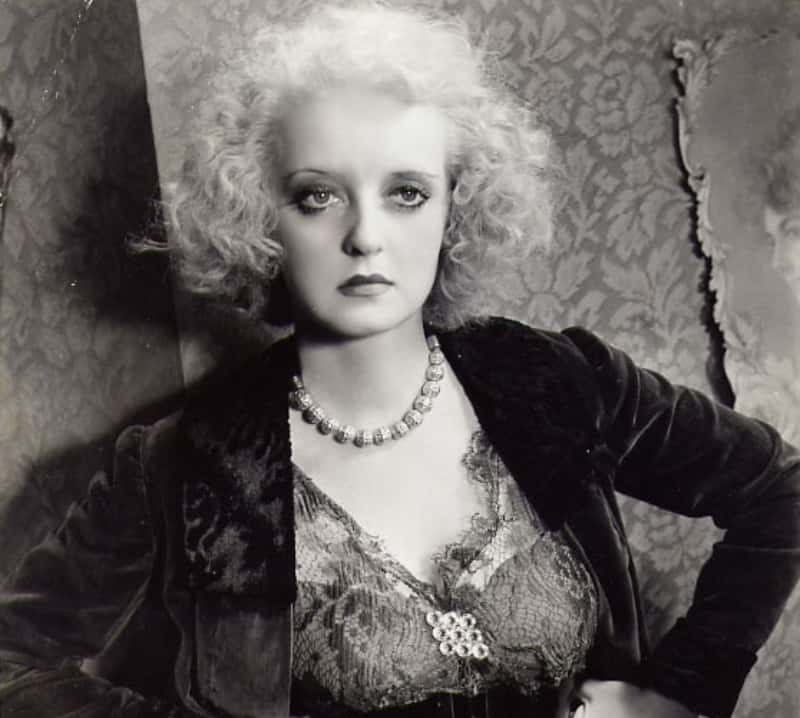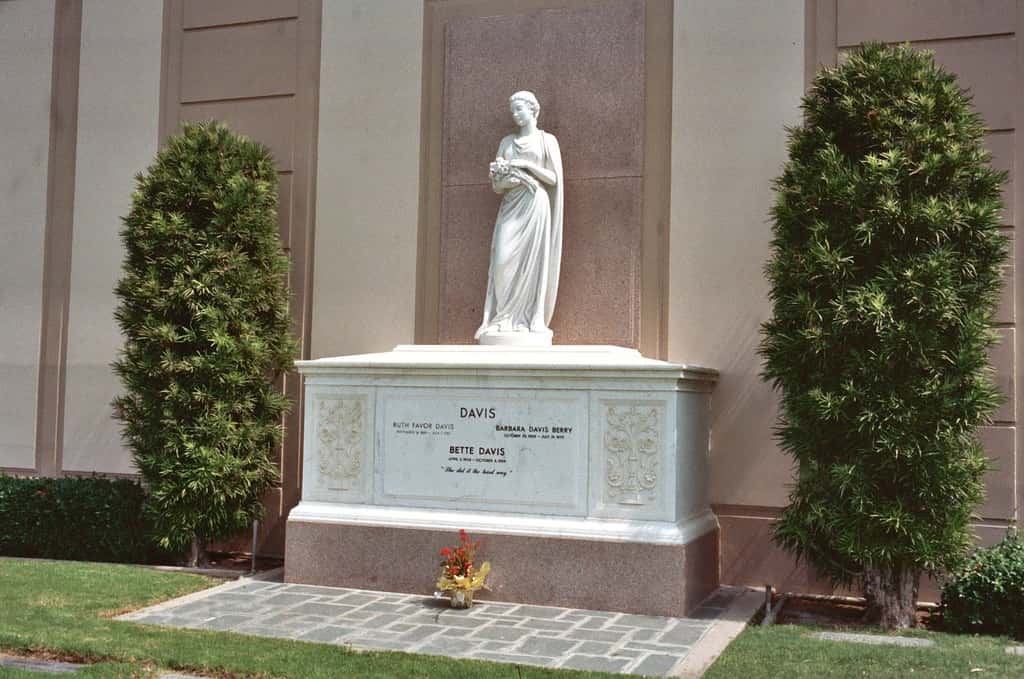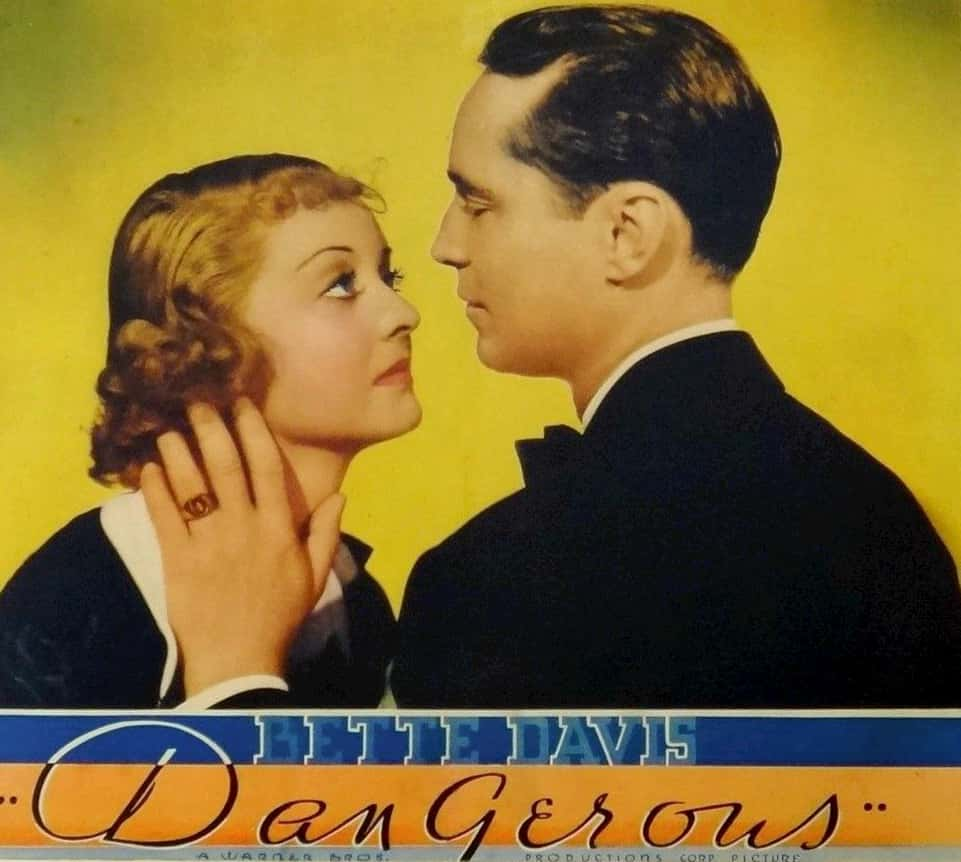Any piece of writing about Bette Davis threatens to just be about her legendary feud with Joan Crawford. That’s most unfortunate, as Davis was a Hollywood juggernaut in her own terms. With her famously big eyes and embrace of “unlikable” characters, Davis put everything she had into her craft. One doesn’t become the first actor to get 10 Oscar nominations without a little bit of elbow grease and a whole lot of talent. Polish that golden statue to these 42 facts about Bette Davis.
Facts About Bette Davis
1. Every Name a Journey
Bette Davis was actually born Ruth Elizabeth Davis on April 5, 1908. She would be known as “Betty” (note: not yet Bette) to her friends…presumably for her middle name, not her first. She dropped the “y” for an “e” into Bette after seeing reading Honoré de Balzac’s novel, La Cousine Bette.
2. Eclipse Your Idols
When asked why went into acting, Davis cited a 1926 production of The Wild Duck starring Peg Entwistle. Just three years later, Davis snagged the part of Hedwig, AKA Entwistle’s role in said show.
3. Taking Time to Catch on
Right from the beginning of her career, people had polarizing opinions about Bette Davis. She was actually turned down by the Manhattan Civic Repertory Theatre for her “frivolous” and insincere” attitude. Likewise, when she went to Hollywood for her first screen test in 1930, a studio head had failed to meet her at the airport because he arrived and saw no one who “looked like an actress”—even thought Davis was right there.
4. Kiss and Tell
While Davis failed her first Hollywood screen-test in 1930, she was “used” in screen tests for other male actors. This involved “intimate” work for which she will ill-prepared. To quote Davis, “I was the most Yankee-est, most modest virgin who ever walked the earth. They laid me on a couch, and I tested 15 men ... They all had to lie on top of me and give me a passionate kiss. Oh, I thought I would die. Just thought I would die."
5. I See Her See Me
Her first contract with Universal Studios was not a success. In 1931, right when the head of studio was about to cut her off, cinematographer Karl Freund praised Davis’s “lovely eyes” and put in her in what would be her film debut, Big Sister. This film…was not a success either, but points to Freund for noticing Davis’s iconic eyes first.
6. Not a 10 in His Books
Early in her career, Davis suffered rather crude comments about her looks. When she tried to dress more seductively for a screen test, director William Wyler loudly mocked her to the crew and stated, “What do you think of these dames who show their chests and think they can get jobs?" On the other end of the spectrum, chief of production Carl Laemmle, Jr. described Davis as having “about as much sex appeal as Slim Summerville,” her gawky male co-star.
7. The Music Ma’am
After a string of failed launches and Universal Studio’s termination of her contract, Bette Davis was going to pack it up and go back to New York. However, she got her big break in George Arliss’s The Man Who Played God, a film about a deaf pianist, with whom Davis’s (much younger) character falls in love. Davis’s performance (and looks) at least received public praise. She credited Arliss with saving her career and stayed with Warner Bros. studio for the next 18 years.
8. An Origin Not Suitable for All Audiences
The Academy Awards are known as “Oscars” thanks to Bette Davis. At least, that’s according to the actress herself. She said the “posterior” of her Best Actress statue, which she won for her 1935 role in Dangerous, reminded her of her first husband, Harmon “Oscar” Nelson.
9. Rose-Colored Film Lenses
Davis has called director William Wyler “the love of [her] life.” And, yes, that’s the same Wyler who once publicly mocked her attempts to be more sexual as a fledging actress. The two embarked on an affair during the filming of Jezebel (1938), which nabbed Davis her second Oscar for her role as a bratty Southern belle. What followed this win was the most consistently successful run of Davis’s career.

History's most fascinating stories and darkest secrets, delivered to your inbox daily.
10. That’s Just Diva Behavior, Honey
Davis was divorced from her first husband in 1938, after evidence was of her affair with director Howard Hughes was revealed. Officially, her “cruel and inhuman manner” was referenced as the inciting cause of separation.
11. The Eyes Have It
Davis was very deliberate about her image. For one, she specifically chose roles that could highlight those famous eyes and preferred to be shot in close-up as much as possible. Maybe that’s why she shaved her own hairline and eyebrows to play Queen Elizabeth I in The Private Lives of Elizabeth and Essex (1939)—the only color film in the apex of Davis’s career.
12. Easy on the Eyes and the Ears
Bette Davis was a big fan of Kim Carnes’ hit song, “Bette Davis Eyes.” She even thanks Carnes for cementing her role in song history as well as film history.
13. Bonding With the Public
Davis played an active role in raising war bonds for the World War II effort. In just two days, she raised over $2 million for the effort, not even including the picture of herself in Jezebel that she sold for $250,000.
14. Entertainment for Everyone
During World War II, Davis performed as the only white member in an acting troupe for an all-black regiment. Her co-stars included Hattie McDaniel, Lena Horne, and Ethel Waters. In pre-segregation America, this was a big deal.
15. Crying All the Way to the Bank
Move over Lindsay Lohan in The Parent Trap—Bette Davis played twins first in A Stolen Life (1946). The film was the only production to come from Davis's own film company and it was not well-received by critics. Fortunately, it made a $2.5 million profit, which makes it one of her biggest financial successes. And isn't that what really matters?
16. Top of the Gold Heap
Bette Davis was declared the highest paid woman in America (not just Hollywood!) in 1947. Ironically, her very next film, Deception (1946), became her first movie to not break even.
17. All About Tragedy
Davis named her second child “Margot” after her own iconic character in All About Eve (1950), Margo Channing. Despite her Hollywood naming, this adopted daughter of Davis did not have a charmed life. Margot suffered a brain injury during birth and had to be institutionalized at the age of 3.
18. The Real Award Is Box Office Returns off the Top
Davis revived her career in the 1960s with What Ever Happened to Baby Jane? It brought her together with longtime rival Joan Crawford and nabbed Davis her 10th and final Best Actress nomination at the Oscars. However, it also added money to her coffers: she got 10% of the worldwide box office as part of her contract.
19. This Machine Ain’t What She Used To Be
1983 was not a healthy year for Bette Davis. Not only was she diagnosed with breast cancer, but she suffered four strokes and became paralyzed on the left side of her face and left arm—just within two weeks of her mastectomy surgery.
 Getty Images
Getty Images
20. The War at Home
In the 1980s, Davis’s daughter, B.D. Hyman, became a born-again Christian. When Davis did not follow suit, their mother-daughter relationship soured. Hyman wrote a shocking book about her relationship with Davis called My Mother’s Keeper. In the book, Davis is portrayed as an overbearing alcoholic. Davis’s other child, Cary Merrill, sided with his mother’s version of events and insisted the book was not accurate. As a result, Hyman was disinherited from her mother’s legacy.
21. Commander in Yawns
Before he was President of the United States, Ronald Regan was Bette Davis’s co-star in Dark Victory (1939). Davis appraised her future Head of State as “dull.”
22. Stick It to the Man
Even during (and after) her intense physical therapy following her four strokes, Bette Davis continued to smoke about 100 cigarettes a day until her death. She preferred Vanguards and smoked them constantly. She couldn’t even let them go for a 10-minute interview.
23. Five Golden Things
Don’t get intimidated or anything: Bette Davis is the first actor to be nominated for five consecutive Academy Awards. Most impressively, they were all in the category for Best Actress, which she dominated with nominations every year from 1938 to 1942.
24. Ten Strikes, You’re out
Bette Davis is also the first person to receive 10 Oscar nominations for her acting work. This has since been surpassed by the likes of Meryl Streep (21 nominations), Katherine Hepburn (12 nominations), Jack Nicholson (also 12 nominations), and then matched by Laurence Olivier (10 nominations). Good company to be in, but she’d want you to remember: Bette Davis did it first.
25. Better Late Than Never?
It was really Davis’s role as a sex worker in Of Human Bondage (1934) that launched her reputation as a truly formidable performer. Many people were outraged that this dramatic turn was not recognized by the Academy. Even Davis herself admitted that her first Oscar for Dangerous the next year was really just “a consolation prize.”
26. One Punch Ma’am
Bette Davis did nothing halfway. Ask Errol Flynn, her co-star in The Private Lives of Elizabeth and Essex. A scene required Davis to slap him—which she did with way more force than needed. Flynn complained to which Davis just quipped “If you can’t take a little slap, that is just too bad!” Can’t take a hit? Just quit.
27. Eager to Be Ugly
Davis wasn’t afraid to look as gross as required by her roles. She did her own makeup to play the titular unhinged has-been in What Ever Happened to Baby Jane? No professional “make-up man” wanted his name attached to how grotesque Davis wanted to look in the movie. To quote the actress, “One told me he was afraid that if he did what I wanted, he might never work again.”
28. Last Laugh
In a twisted act self-awareness about her waning star (or maybe a publicity stunt), Bette Davis put out this employment ad in the papers just nine days after filming What Ever Happened to Baby Jane?:
“’Situation Wanted, Women. Mother of three—10, 11 & 15—divorcee. American. Thirty years’ experience as an actress in motion pictures. Mobile still and more affable than rumor would have it. Wants steady employment in hollywood. (has had broadway.) Bette davis, c/o martin baum, g.a.c. references upon request.”
29. You Can’t Put a Price on Acclaim…or Can You?
Both of Bette Davis’s Best Actress Oscars—for Dangerous (1935) and Jezebel (1938)—were bought by Steven Spielberg for, respectively, for $207,500 and $578,00. He did the “right” thing and donated them back to the Academy of Motion Picture Arts and Sciences.
 Getty Images
Getty Images
30. A Final Staycation
Bette Davis died of cancer in France on October 6, 1989. She had traveled to Europe after collapsing at the 1989 America Cinema Arts Awards. Unfortunately, time away from the States was not enough to recuperate her health. She was 81 years old.
31. Never Too Early for Funeral Planning
Bette Davis entombed herself in style. She is interred in a specialized crypt between her brother Bobby and her mother Ruthie—her name is in the bigger typeface, of course. Her tomb also reads “She did it the hard way.” Apparently, Davis had this epitaph in mind for almost 40 years, as early as when she was filming All Above Eve (1950), when it was proffered to her by Joseph L. Mankiewicz. What better place to plan your gravestone than the watercooler?
32. Win-Lose Situation
Bette Davis and Errol Flynn in Gone With the Wind? It almost happened. Following her Oscar-winning turn as a haughty Southern belle in Jezebel, Davis’s name was in the first in the running to play a more iconic Southern Belle, Scarlett O’Hara, in Gone With the Wind. Davis herself expressed interest and a radio poll ranked her as audience fave to take on the big hoop skirt again.
Davis’s mentor offered director David O. Selznick a package deal, where Errol Flynn would also be cast. Selznick did not want to work with Davis; Davis did not want to work with Flynn. Everyone got what they wanted and also nothing they wanted. The movie ultimately starred Vivien Leigh and Clark Gable as Rhett Butler.
33. Mr. Insecurity
Despite her growing wealth in the early days of her fame, Davis could not buy her own house until her first husband, Harmon Oscar Nelson, could save enough to buy one himself. Nelson refused to be so “emasculated” by his wife.
34. Not Taking Fruit
Davis had multiple abortions during her first marriage to Harmon Oscar Nelson. With his insecurities about her success, it was likely not a particularly happy marriage.
35. Head Case
During the war, Davis tragically lost her second husband, Arthur Farnsworth, but he did not die in battle. However, his death was due to violent reasons: he passed out in a Hollywood street and died two days later. When the autopsy came back, it revealed that he died from a skull fracture incurred two weeks before. Davis testified she didn’t know what could possibly have caused the fatal injury. Farnsworth’s death was labeled an accident.
36. The Enemy of My Enemy Is My Soda
Any article about Bette Davis threatens to be eclipsed by her feud with Joan Crawford. The big rivalry led inspired a string of petty moves throughout the filming of one of their movies. As the widow of the Pepsi Cola Company CEO, Crawford was on the company’s board of directors. Naturally, Davis installed a pop machine on the set of a film they made together—one for Pepsi’s natural enemy, Coca-Cola.
37. An Award-Winning Triangle
Dangerous (1935) was the role that got Davis her first Oscar for Best Actress…but it also arguably kick-started her feud for Joan Crawford. While filming Dangerous, Davis fell in love with her co-star, Franchot Tone, whom Crawford was dating. Their chemistry did not go unnoticed by Crawford, who pressured Tone into a quick engagement while they were still filming. Davis never forgave Crawford for “stealing” back her own man.
38. More Than Frenemies?
In more amicable days, Joan Crawford tried to make nice with Bette Davis by sending gifts and flowers to the latter’s dressing room. Davis glibly shot down Crawford’s olive branches as “lesbian overtures.” (Bisexual rumors followed Crawford throughout her career, which leads some avid theorists to suggest her feud with Davis was fueled by spurned attraction as much as jealousy.
39. Revenge Is a Dish Best Served in Gold
Bette Davis famously did not win her 10th and final Oscar nomination for What Ever Happened to Baby Jane? To add insult to injury, her co-star Joan Crawford was there to rub salt in the wound. Crawford had convinced the four other Best Actress nominees, who could not show up, to let her accept on their behalf if they won. Not being able to beat those 4-to-1 odds, Davis had to watch her lifelong enemy Crawford take the award onstage.
40. Stepping up to the Plate
Bette Davis was originally offered the titular role in Mildred Pierce. She turned it down to play a coal miner’s tutor in The Corn is Green, and it went to her arch-enemy Joan Crawford. While Davis’s performance in drab wear was well-received, it was Crawford who won her third Oscar in a role that Davis thought she was above. Awkward.
41. Pettiness for Two
In 1952, Bette Davis was all too eager to play a very loosely veiled caricature of Joan Crawford in The Star. She played Margaret Elliot, a washed-up Oscar-winner who suffers a series of indignities for her bad attitude. The screenplay was even written by Joan’s ex-friend, Katherine Albert.
42. Mothers Before Others
In her feud with Joan Crawford, Bette Davis drew the line at supporting daughterly “ingratitude.” When Joan’s daughter Christine penned her shocking anti-Crawford book Mommie Dearest, Davis stood up for Crawford: “I was not Miss Crawford’s biggest fan, but, wisecracks to the contrary, I did and still do respect her talent. What she did not deserve was that detestable book written by her daughter.”
Stay classy, Bette.
Christine Crawford



















































